Role of Toxins in Plant Pathogenesis : The process of pathogenesis (the onset of diseased condition) in plants is facilitated by many factors such as virulence of the pathogen, susceptibility of the host, presence of suitable environmental conditions and various enzymes and metabolites of pathogens. Previously we have discussed the importance of different enzymes involved in plant pathogen interactions. These enzymes facilitate the entry of the pathogen into the host and help to colonize inside the host cell. The production of different hydrolytic enzymes may not always result in the establishment of pathogen inside the host tissue.
Certain plant pathogen may successfully invade the host tissue area but fail to induce the onset of disease. These findings highlighted the involvement of certain toxins, microbial toxins or aggressins, in the establishment of diseased conditions in plants. The present post describes the Toxins involved in plant pathogen interaction and pathogenesis with examples.
What is meant by ‘toxin’ in Plant Pathology?
Ø Definition: Any substances produced by a pathogen which is injurious to host and it directly and immediately play a crucial role in pathogenesis.
Ø Toxins involved in plant parasite interactions are also called as aggressin.
Ø According to Koch’s postulates, a substance to be called as a ‘toxin’ should follow the following criterions:
@. The compound must be isolated from the diseased plant
@. It should NOT be present in the healthy plant
@. Compound must be chemically characterized
@. When isolated toxin is reintroduced to a healthy host, it should produce the original symptoms.
How toxins in plant pathogen interactions are classified?
Ø Toxins in plant parasite interactions are classified into two groups (figure above):
(1). General toxins
(2). Specific toxins
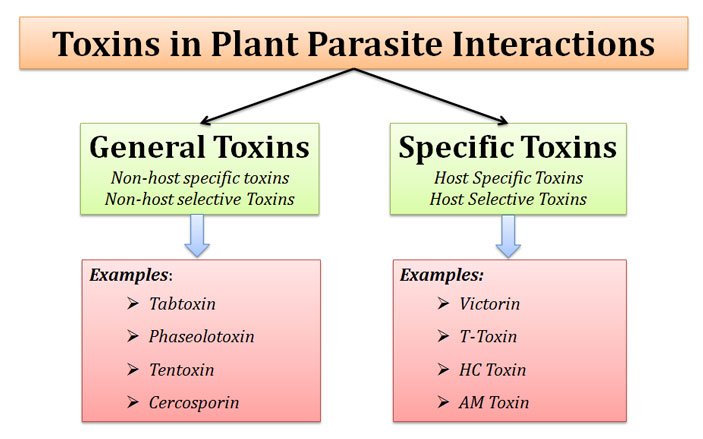
General toxins
Ø They are also called as non-host specific toxins or non-host selective toxins.
Ø These toxins produce all or part of the disease syndrome not only on the host plant but also on other species of plant that are not normally attacked by the pathogen in nature.
Ø This means that general toxins are not host specific or host selective.
Ø Specific pathogen can produce these toxins in any host species.
Examples of general or non-host specific toxins are:
(A). Wildfire toxin or Tabtoxin
(B). Phaseolotoxin
(C). Tentoxin
(D). Cercosporin
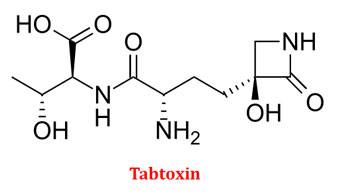 Wildfire toxin or Tabtoxin
Wildfire toxin or Tabtoxin
Ø Wildfire toxin is a general toxin produced by bacterium Pseudomonas syringae pv. tabaci.
Ø This pathogen causes wildfire disease in tobacco.
Ø Isolated toxin produces similar disease in other plants also.
Ø Tabtoxin is a dipeptide toxin composed of two amino acids: Threonine and Tabtoxinine.
Ø Tabtoxin as such is not toxic to plants.
Ø In the cell, it becomes hydrolyzed to release tabtoxinine.
Ø Tabtoxinine inactivates the enzyme glutamine synthase in plants.
Ø Inactivation of glutamine synthase leads to depleted glutamine level.
Ø This results in the accumulation of ammonia in the cells.
Ø Accumulated ammonia uncouples the photosynthesis and photorespiration.
Ø Ammonia also destroys thylakoid membrane of chloroplast leading to chlorosis and eventually necrosis.
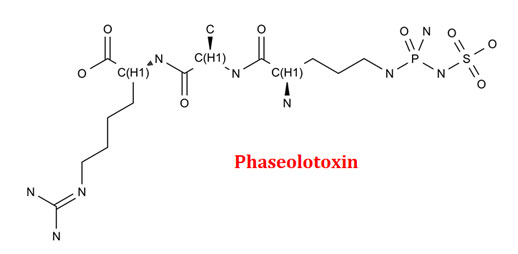 Phaseolotoxin
Phaseolotoxin
Ø Phaseolotoxin is a general toxin produced by a bacterium Pseudomonas syringae pv. Phaseolicola.
Ø This bacterium causes halo blight in beans and other legumes.
Ø Plants treated with this toxin show original symptoms on non-host plants.
Ø Reduced growth, disruption of apical dominance and accumulation of amino acid ornithine are the effects of phaseolotoxin.
Ø Phaseolotoxin is tripeptide toxin composed of ornithine-alanine-arginine.
Ø This tripeptide also carries a phosphosulfamyl group.
Ø The toxin is cleaved by the host enzymes to release alanine, argininine and phospho-sulfamylornithine (PSMO).
Ø PSMO is the functional moiety of the toxin.
Ø PSMO inactivate the enzyme ornithine carbamoyltransferase (which normally converts ornithine to citrulline, a precursor of arginine).
Ø By this action accumulation of ornithine and depleted level of arginine occurs in the cells.
Ø Other physiological effects of Phaseolotoxin:
§ Inhibit pyrimidine nucleotide biosynthesis
§ Reduce the activity of ribosome
§ Interfere with lipid biosynthesis
§ Change the permeability of membranes
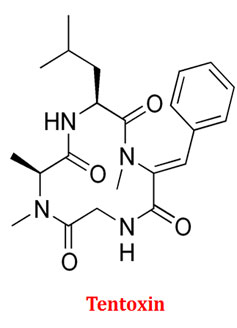 Tentoxin
Tentoxin
Ø It is a general toxin produced by a fungus Alternaria alternata
Ø Alternaria alternata cause chlorosis in seedlings of many plants.
Ø Tentoxin is a cyclic tetrapeptide.
Ø Tentoxin binds and inactivate proteins involved in energy transfer in chloroplasts.
Ø It also inhibits the photophosphorylation process in the leaves and thus reduces the formation of ATP.
Ø Tentoxin also interfere with normal chloroplast development and chlorophyll synthesis and thus they induce chlorosis in leaves.
Ø The exact mechanism of action of tentoxin is still not clear.
| You may also like NOTES in... | ||
|---|---|---|
| BOTANY | BIOCHEMISTRY | MOL. BIOLOGY |
| ZOOLOGY | MICROBIOLOGY | BIOSTATISTICS |
| ECOLOGY | IMMUNOLOGY | BIOTECHNOLOGY |
| GENETICS | EMBRYOLOGY | PHYSIOLOGY |
| EVOLUTION | BIOPHYSICS | BIOINFORMATICS |
Cercosporin
Ø Cercosporin is a general fungal toxin produced by many species Cercospora.
Ø This pathogen cause leaf spots and leaf blight disease in several plants.
Ø The cercosporin toxin is activated by the light.
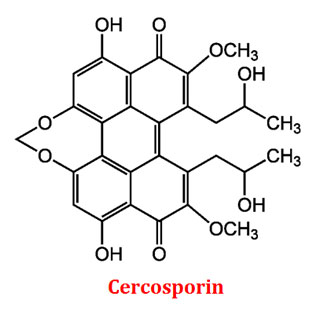 Ø Activated toxin reacts with oxygen to produce singlet oxygen.
Ø Activated toxin reacts with oxygen to produce singlet oxygen.
Ø This reactive singlet oxygen destroys the host membrane system.
Ø They can react with lipids, proteins and nucleic acid of the host cells.
Ø Fungal mycelium is able to tolerate the toxin.
Ø Fungal mycelium produce pyridoxine (Vitamin B6) which neutralize the reactive oxygen
Specific toxins
Ø They are also called as host specific toxins or host selective toxins.
Ø These toxins produce the disease syndrome only on specific parasite and host combination.
Ø Specific toxins are NOT produced when a pathogen attack a non-host plant or another host plant
Ø This means that, specific toxins are host specific or host selective toxins
Ø Specific pathogen can produce these toxins ONLY in specific host species.
Ø Examples of host specific toxins:
(A). Victorin or HV toxin
(B). T-toxin (Cochliobolus heterostrophus race T-toxin)
(C). HC Toxin
(D). AM Toxin
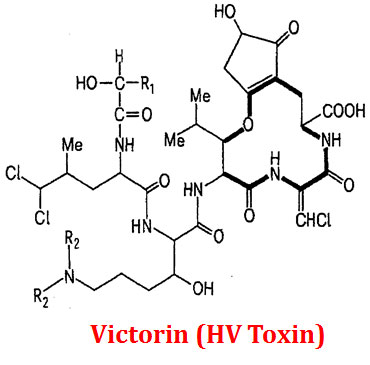 Victorin or HV Toxin:
Victorin or HV Toxin:
Ø This toxin is produced by Helmonthosporium victoria (Syn: Cochliobolus victoria)
Ø This pathogen is very selective and specifically infects the Victoria variety of oats.
Ø Pathogen infects the basal portion of the host and produces toxins.
Ø This toxin then translocated to leaves where it causes the blight disease.
Ø In severe infection, the plant is destroyed completely.
Ø The pathogen is not able to produce the vctorin toxin when they infect other species or even other varieties of oats.
Ø Toxin production in the fungus is controlled by a single gene.
Ø The expression of this gene is controlled by factors of host origin.
Ø Victorin toxin also affects cell wall, increase respiration and decrease protein synthesis in host cells.
Ø Strains of Cochliobolus which are not able to produce this toxin are avirulent and not able to induce the blight disease.
Ø This means that the production of victorin toxin is essential for the pathogenesis.
Ø Victorin is a peptide toxin and it is has a complex cyclic pentapeptide structure.
Ø The primary target of the protein is cell membrane of host cells.
Ø It also affects metabolism in the susceptible plants.
T-toxin
Ø Produced by T-race of Cochliobolus (Helminthosporium) heterostrophus
Ø This pathogen causes leaf blight in corns.
Ø T-race differ from others strains of the pathogen only in the ability to produce this toxin.
Ø T-race only attacks the Texas male sterile (TMS) cultivar of corns.
Ø Other cultivars are resistant to pathogen and toxin.
Ø T-toxin is essential for the pathogenicity (virulence).
Ø T-toxin is a mixture of long linear polyketol derivative.
Ø The toxin specifically affects the selective permeability of mitochondrial membrane and inhibits ATP synthesis.
Ø T-toxin is specific to a receptor URF13 present in inner mitochondrial membrane of host cells.
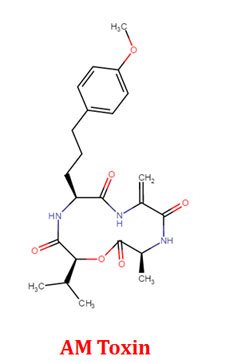 HC-Toxin
HC-Toxin
Ø Produce by Cochliobolus (Helminthosporium) carbonum.
Ø This pathogen causes leaf spot disease in maize.
Ø HC-toxin is specific to specific cultivars.
Ø Detailed mechanism of action of HC toxin is not understood.
Ø Biochemical and molecular genetic basis of resistance against HC-toxin is understood.
Ø The resistant varieties of corn have a gene HM1 coding for an enzyme, HC toxin reductase which reduces and detoxify the toxin.
Ø This particular gene is absent in susceptible varieties of corn.
AM Toxin
Ø Produced by Alternatia alternata (previously referred to as Alternaria mali).
Ø This pathogen causes Alternaria leaf blotch of apple.
Ø AM toxin is a cyclic peptide and usually existing as a mixture of different forms.
Ø AM toxin acts selectively on susceptible varieties of apple.
Ø Resistant varieties tolerate AM toxin (even more than 1000X concentration).
Ø The AM toxin causes invagination of plasma membrane in susceptible hosts.
Ø The toxin also causes rapid loss of chlorophyll.
Other toxins in plant pathogen interactions:
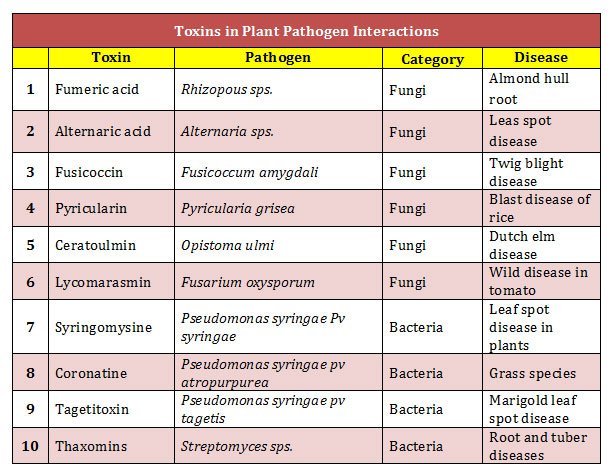

Thank u so much…it was helpful😊
good